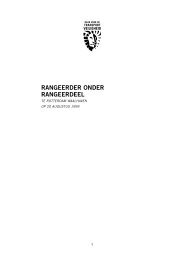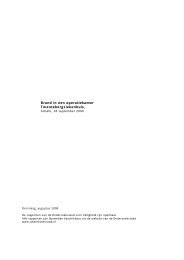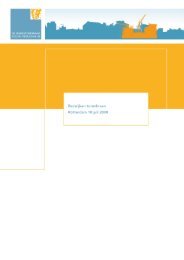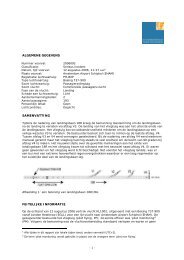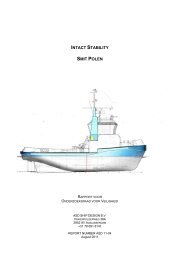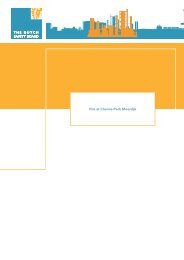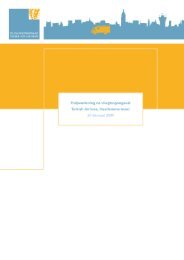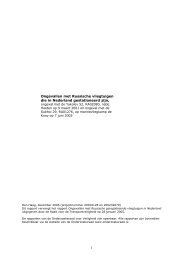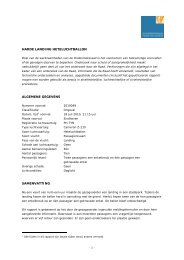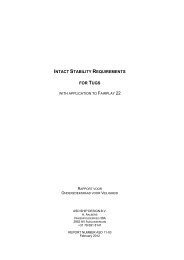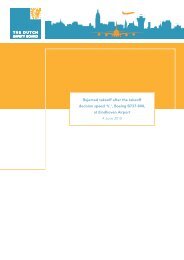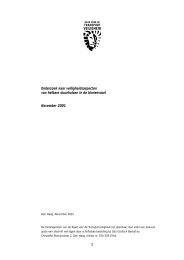Breaking of mooring lines whilst mooring m.v. Edisongracht between ...
Breaking of mooring lines whilst mooring m.v. Edisongracht between ...
Breaking of mooring lines whilst mooring m.v. Edisongracht between ...
You also want an ePaper? Increase the reach of your titles
YUMPU automatically turns print PDFs into web optimized ePapers that Google loves.
usual, which would have been parallel to the heading <strong>of</strong> the vessel, but to run somewhat crosswiseto the vessel. This lateral current was caused by the additionally high water level, through whichsandbanks were washed over and water could flow into the channel without being hampered. Thecurrent estimated by the Captain on arrival <strong>between</strong> the <strong>mooring</strong> buoys was 2-4 knots 11 .The moment at which the <strong>mooring</strong> manoeuvre <strong>between</strong> the <strong>mooring</strong> buoys initiated, wasunsuitable due to the very strong tidal current that was present when the accident occurred. Theseunfavourable conditions were encountered as a result <strong>of</strong> the decision to moor the vessel <strong>between</strong>the <strong>mooring</strong> buoys despite the delay <strong>of</strong> 2.5 hours.The Captain knew that he would not be able to execute the <strong>mooring</strong> manoeuvre during slack tideas a result <strong>of</strong> the postponed departure and that a spring tide would be present. What the Captainpossibly could not have known and the pilot should well have known, is that this spring tide wouldnow run slightly crosswise <strong>of</strong> the vessel. Normally, this current would run in the North-Southdirection <strong>of</strong> the channel and therefore lengthwise <strong>of</strong> the vessel. This unusual diagonal current wasthe result <strong>of</strong> water running over the sandbanks, which could now flow freely without any obstacle.It could not be determined whether or not the Captain was informed about this.The Captain, who has the ultimate responsibility, must have sufficient information to ensure he cansafely manoeuvre. In this instance, the Captain was to a large extent depending on localknowledge and judgements <strong>of</strong> the pilot and port authorities. The Captain was - as transpired later -repeatedly incorrectly informed about the arrival time <strong>of</strong> the pilot and was not or insufficientlyinformed by the pilot that the moment chosen to initiate the <strong>mooring</strong> manoeuvre was unsuitable.4.2 Mooring <strong>between</strong> the <strong>mooring</strong> buoysIn the port <strong>of</strong> Kwanda Base two <strong>mooring</strong> buoys that were specifically placed for this project werepresent <strong>between</strong> which the vessel had to moor. The distance <strong>between</strong> the <strong>mooring</strong> buoys wasapproximately 350 metres. The location <strong>between</strong> the <strong>mooring</strong> buoys is used to speed up theunloading <strong>of</strong> the cargo. This way, the transfer <strong>of</strong> the pipes to the work boats can take place on bothsides <strong>of</strong> the ocean-going vessel with its on board cranes. It was deemed desirable by the crew toextend the <strong>mooring</strong> <strong>lines</strong> by using <strong>mooring</strong> <strong>lines</strong> with the same breaking load (36.3 MBL) due tothe length <strong>of</strong> the m.v. <strong>Edisongracht</strong>, the length <strong>of</strong> the fixed <strong>mooring</strong> <strong>lines</strong> on the winches and thecurrent that was flowing. The <strong>mooring</strong> <strong>lines</strong> were, however, connected using a shackle with a lowermaximum allowed load (20 SWL). This means that these parts (i.e. the <strong>mooring</strong> <strong>lines</strong> and shackle)were not properly matched.4.3 Tug assistanceIt was the third time in a month that this crew would moor the vessel <strong>between</strong> the <strong>mooring</strong> buoysin the port. Just like the previous two times the vessel was assisted by two tugs that sailedalongside the vessel in standby mode during the <strong>mooring</strong> manoeuvre <strong>between</strong> the <strong>mooring</strong> buoys.These tugs were stationed at the port <strong>of</strong> Soyo. Under the conditions that prevailed at the previoustwo times (average tide and little to no current), the performances <strong>of</strong> the tugs were sufficient toturn the vessel around, to stop it <strong>between</strong> the <strong>mooring</strong> buoys and to ensure it stayed in thatposition.11The Guide<strong>lines</strong> <strong>of</strong> Port Entry <strong>of</strong> Kwanda (review: 01-12-2008) specify that current speeds <strong>of</strong> more thanfive knots can be present at Kwanda Base.For reference purposes: The average peak current speed as a result <strong>of</strong> the effect <strong>of</strong> the tides on theNieuwe Waterweg (Port <strong>of</strong> Rotterdam, the Netherlands) is approximately 2.7 knots.- 13 -



